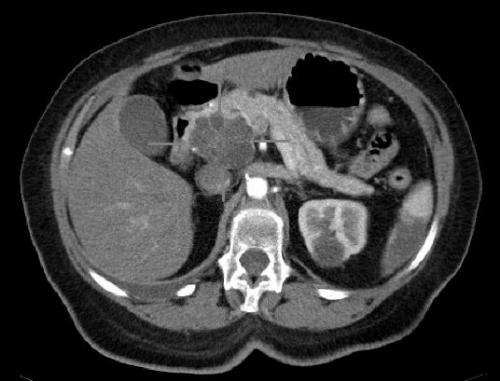This article has been reviewed according to Science X's editorial process and policies. Editors have highlighted the following attributes while ensuring the content's credibility:
fact-checked
peer-reviewed publication
trusted source
proofread
New approach to pancreatic cancer treatment expands therapeutic possibilities, shows promise for increased survival

Preclinical research published in the Journal for ImmunoTherapy of Cancer points to a promising new treatment option for people with pancreatic cancer. Researchers from VCU Massey Comprehensive Cancer Center and the VCU Institute of Molecular Medicine (VIMM) suggest that when used in a form that can be delivered directly into the tumor cell, polyinosine–polycytidylic acid (pIC) suppresses tumor growth, induces cancer cell death and enhances survival in animal models with the most common form of pancreatic cancer.
Researchers also concluded that when used alone or in combination with a standard-of-care medication such as gemcitabine, pIC—a double-stranded RNA which acts as an immunostimulant—is safe and non-toxic to normal pancreatic cells, indicating this approach may have translational potential to improve the survival of people with pancreatic ductal adenocarcinoma (PDAC).
PDAC is one of the most difficult cancers to treat effectively, with a one-year survival rate of 24% and a five-year survival rate of just 9%. In the article, researchers co-led by Paul B. Fisher, M.Ph., Ph.D., FNAI, the Thelma Newmeyer Corman Endowed Chair in Cancer Research at Massey and director of the VIMM, showed the treatment combination significantly enhances the survival of immune-competent mice with PDAC tumors which capture the properties of human pancreatic cancer.
This research is the extension of pioneering work originally done by Fisher and colleagues to define ways of enhancing the anti-cancer activity of pIC. Previous clinical trials with pIC showed limited activation of the immune response and no detectable antitumor effects in melanoma or other cancers. However, when delivered into the tumor cell's cytoplasm using polyethyleneimine (PEI), a synthetic, water-soluble polymer, pIC can successfully enter the cell and stimulate tumor cell death.
The current work, co-authored with Luni Emdad, M.B.B.S., Ph.D., associate professor in VCU's Department of Human and Molecular Genetics and a member of the VIMM, and others documents a profound response in animals with PDAC when pIC is effectively delivered into tumor cells using PEI.
"Previous laboratory and preclinical studies have shown this method to also be effective in a number of other cancers, including breast, melanoma and liver cancer," said Fisher, who is also a professor in the Department of Human and Molecular Genetics at VCU School of Medicine.
"In studying this phenomenon in mice with an intact immune system, we found that it worked exceptionally well in PDAC, extending life to an amazing degree just on its own, and enhanced even further in combination with gemcitabine. Nothing like this has been seen before when looking at the original pIC molecule without the use of PEI or other therapeutic modalities in PDAC."
The study also demonstrates the mechanism of pIC's effectiveness, and the immune system's profound role in that pathway. The pIC activates Stat1, a gene expression stimulatory molecule, which in turn activates chemokines—proteins that stimulate immune cell migration—to heighten the immune system's response to the cancerous cells. The reaction converts tumor-associated M2 macrophages into M1 macrophages, turning the molecular machinery that was responsible for creating cancerous cells into a system that attacks the cancer.
Since the toxicity profiles of both gemcitabine and pIC are known, said Emdad, scientists can feel confident that the approach is safe to proceed to test its effectiveness in human studies.
"PDAC is a devastating disease. Our survival data is so encouraging in these mice, we consider the potential impact of our treatment on humans will be significant," said Emdad.
In another promising takeaway from the study, pretreatment of mice with pIC prior to cancer development slowed eventual tumor growth by approximately 60%, suggesting that the molecule induced a protective, vaccine-like effect in the mice. This is an area the researchers identified as needing further study, to investigate possible cancer prevention implications.
Fisher said that though this study's positive results are demonstrated specifically in pancreatic cancer, the approach should work in multiple cancer types and could become a generalized therapy in combination with cancer-specific standards of care. Moreover, encouraging data in phase I studies using pIC-PEI (BO-112) as a single agent, or in combination with the immune checkpoint inhibitor anti-PD-1, was found safe and manageable in patients with aggressive solid cancers other than PDAC.
"The big picture is that this approach works, and it's ready to go into the clinic to treat patients with pancreatic cancer," said Fisher. "Translating discoveries that originate in the laboratory into effective therapies is a major challenge that, when accomplished, represents the ultimate achievement of basic medical research. For PDAC patients, we think there could be a light at the end of the tunnel."
More information: Praveen Bhoopathi et al, Cytoplasmic-delivery of polyinosine-polycytidylic acid inhibits pancreatic cancer progression increasing survival by activating Stat1-CCL2-mediated immunity, Journal for ImmunoTherapy of Cancer (2023). DOI: 10.1136/jitc-2023-007624
















